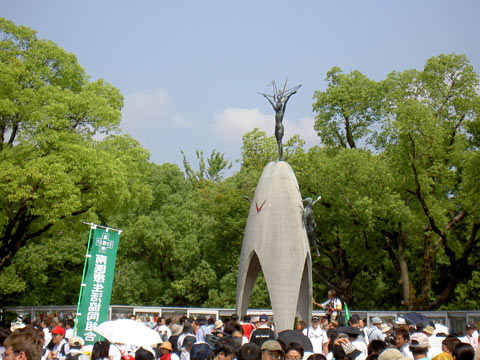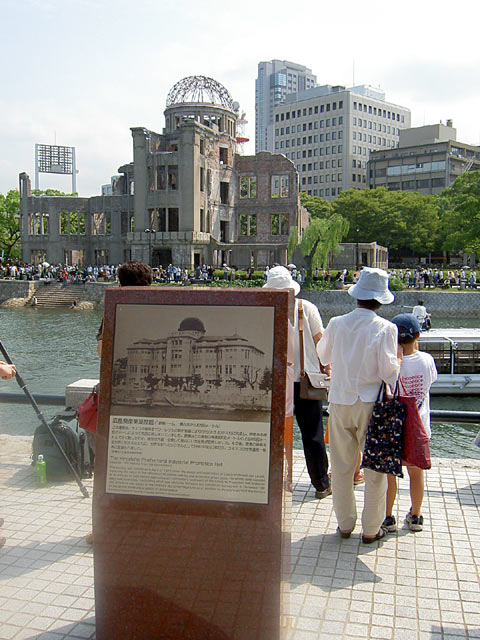

Catherine Robertson sent us this report and photos on her return from Japan.
8. Hiroshima Peace Conference and Commemoration Ceremony, August 2005

Children's Peace Memorial

The A-Bomb Dome, formerly the Prefecture
I visited Hiroshima this year as a representative for the Youth & Student section of CND (Campaign for Nuclear Disarmament). 2005 marks 60 years since an atomic bomb was dropped on Hiroshima.
On the day before the commemoration ceremony, there was an opportunity to meet people from across the world who had travelled to attend the conference. Each delegate had their own story to tell about campaigning against nuclear weapons in their own country: Mouvement de la Paix sent a large delegation which included around 20 young people. They spoke about their sorrow and shame as they listened to the memories of a survivor of the bombing (hibakusha) and knew that their own government was one of those to maintain a nuclear arsenal: an emotion I could well relate to.
Hearing the stories of the hibakusha, who had been in Hiroshima on 6th August 1945, was an important part of the conference. There was a real sense that these stories need to be passed on to younger generations and to different countries so that people can begin to understand the real horror of nuclear weapons. One man who spoke had been a school boy at the time and recollected how he, as monitor, had chosen which of his class-mates would help with clearing rubble in the city centre. All those who were chosen were close to the epicentre and died in the bomb blast. Another man, a young doctor at the time, spoke about his fear and horror as people who had come into Hiroshima to search for loved ones began to develop skin sores and to grow weak and die. They could not, he said, understand how people who had not even been in the city at the time of the bombing could be affected by the blast. We know that it was radiation sickness which caused the suffering. By the end of 1945, 150,000 people in Hiroshima had died because of the atomic bomb. By the end of 1995, the number of hibakusha who had died of causes related to the atomic bombing had risen to 350,000.
The Friday evening saw a women's forum in the largest room in the city sports centre. The hall was packed and the forum was a moving, inspiring combination of song and speech. The mood is difficult to describe: sadness and hope mingled with defiance and anger.
The ceremony on Saturday morning attracted tens of thousands of people. The
mayor of Hiroshima dedicated the register of names of people who had been killed
by the atomic bomb. Flowers were laid and there was a silent time for personal
reflection. Doves were released to show a hope for peace and delegates each
made a paper crane. These were collected to be given to the government of a
nuclear weapon state. The addresses were varied in terms of who was speaking
and what was said, but three common themes emerged: firstly, sorrow for the
dead and their families; secondly, solidarity with the hibakusha and determination
to support them (at the moment there are many hibakusha who are receiving no
financial support, as they live outside of Japan and are unable to fulfil the
requirement to travel back to Japan to make a claim). The third message was
that, as the first city, and the only country to have experienced the devastation
of an atomic bomb, there is a duty to work for peace and to tell the world about
the horrific destruction caused by the bomb. Along with this, there was a clear
recognition of Japan's past, during WWII and before, in colonising and dominating
countries in Asia. The Korean people who were enslaved in Japan and who were
killed by the atomic bomb were mentioned and mourned for, and this recognition
strengthened the resolve to work for peace.
Article 9 of the Japanese constitution reads: "Aspiring sincerely to an
international peace based on justice and order, the Japanese people forever
renounce war as a sovereign right of the nation and the threat or use of force
as a means of settling international disputes. In order to accomplish the aim
of the preceding paragraph, land, sea, and air forces, as well as other war
potential, will never be maintained. The right of belligerency of the state
will not be recognized". International pressure on Japan to support the
so-called 'war on terror' and the attack and occupation of Iraq has led the
government to debate the article and whether it should be struck from the constitution.
This was a major theme at the conference, seen on every stall in leaflets, T-shirts
and badges. There is outrage that the peaceful nature of the Japanese constitution
could be abolished and an understanding of the incompatibility of this act with
the desire to spread the message and hope of peace. The Japanese Prime Minister
received the most muted applause at the peace ceremony.
The evening of August 6th saw a lantern floating ceremony on the river that
runs through Hiroshima. Sixty years ago, people fled to the river, desperate
for relief from the terrible burning. As we now know, the water was contaminated
with radiation and the relief of the water led to the anguish of radiation sickness.
The river plays an important part in the city and in the remembrance of the
bombing.
I'd read a lot about Hiroshima before I went. I'd seen the stories of people
killed in the bombing and of people who survived. Visiting the city and taking
part in the conference and peace memorial ceremony made the bombing real to
me. One woman, Yayoi, who was putting up delegates in her house, went to visit
the graves of her sister, mother and father on August 6th. That brought home
the reality of a young girl losing her entire family. The stories of hibakusha
have been told in a number of national newspapers in this country, but always
in a historical context - was it right to use an atomic bomb on Hiroshima and
again on Nagasaki. The connection is almost never made between the indiscriminate
destruction caused sixty years ago and the even greater destructive power possessed
now by this country, in the form of Trident. Nowhere did I see a journalist
make the connection with the fact that a possible replacement for Trident is
to be discussed in this parliament. Yayoi's story, and the stories of the other
hibakusha need to be told as something with real relevance for today, for every
country.
Catherine Robertson, Youth and Student CND
oxford@youthstudentcnd.org.uk